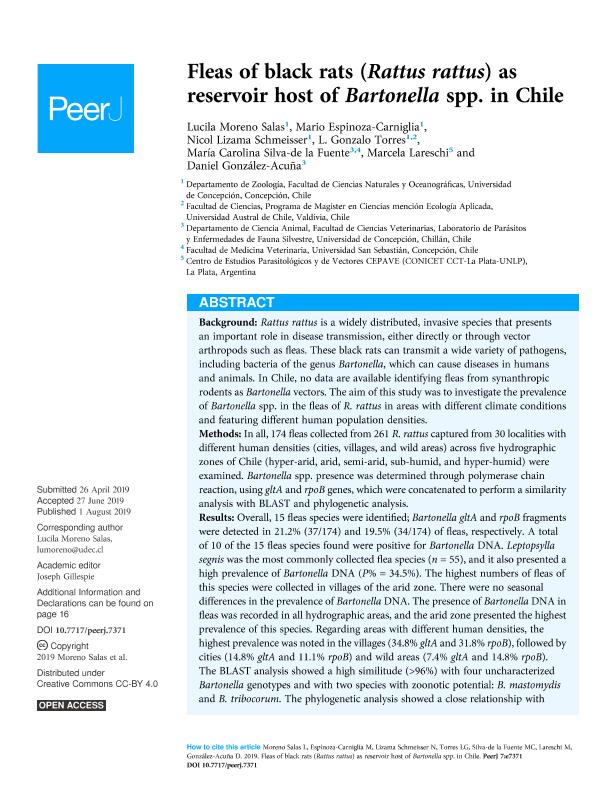Artículo
Fleas of black rats (Rattus rattus) as reservoir host of Bartonella spp. In Chile
Moreno Salas, Lucila; Espinoza Carniglia, Mario Virgilio ; Lizama Schmeisser, Nicol; Torres, L. Gonzalo; Silva de la Fuente, María Carolina; Lareschi, Marcela
; Lizama Schmeisser, Nicol; Torres, L. Gonzalo; Silva de la Fuente, María Carolina; Lareschi, Marcela ; González Acuña, Daniel
; González Acuña, Daniel
 ; Lizama Schmeisser, Nicol; Torres, L. Gonzalo; Silva de la Fuente, María Carolina; Lareschi, Marcela
; Lizama Schmeisser, Nicol; Torres, L. Gonzalo; Silva de la Fuente, María Carolina; Lareschi, Marcela ; González Acuña, Daniel
; González Acuña, Daniel
Fecha de publicación:
08/2019
Editorial:
PeerJ Inc.
Revista:
PeerJ
ISSN:
2167-8359
Idioma:
Inglés
Tipo de recurso:
Artículo publicado
Clasificación temática:
Resumen
Rattus rattus is a widely distributed, invasive species that presentsan important role in disease transmission, either directly or through vectorarthropods such as fleas. These black rats can transmit a wide variety of pathogens, including bacteria of the genus Bartonella, which can cause diseases in humans and animals. In Chile, no data are available identifying fleas from synanthropic rodents as Bartonella vectors. The aim of this study was to investigate the prevalence of Bartonella spp. in the fleas of R. rattus in areas with different climate conditions and featuring different human population densities. In all, 174 fleas collected from 261 R. rattus captured from 30 localities with different human densities (cities, villages, and wild areas) across five hydrographic zones of Chile (hyper-arid, arid, semi-arid, sub-humid, and hyper-humid) were examined. Bartonella spp. presence was determined through polymerase chain reaction, using gltA and rpoB genes, which were concatenated to perform a similarity analysis with BLAST and phylogenetic analysis.Results: Overall, 15 fleas species were identified; Bartonella gltA and rpoB fragments were detected in 21.2% (37/174) and 19.5% (34/174) of fleas, respectively. A total of 10 of the 15 fleas species found were positive for Bartonella DNA. Leptopsylla segnis was the most commonly collected flea species (n = 55), and it also presented a high prevalence of Bartonella DNA (P% = 34.5%). The highest numbers of fleas of this species were collected in villages of the arid zone. There were no seasonal differences in the prevalence of Bartonella DNA. The presence of Bartonella DNA in fleas was recorded in all hydrographic areas, and the arid zone presented the highest prevalence of this species. Regarding areas with different human densities, the highest prevalence was noted in the villages (34.8% gltA and 31.8% rpoB), followed by cities (14.8% gltA and 11.1% rpoB) and wild areas (7.4% gltA and 14.8% rpoB). The BLAST analysis showed a high similitude (>96%) with four uncharacterized Bartonella genotypes and with two species with zoonotic potential: B. mastomydisand B. tribocorum. The phylogenetic analysis showed a close relationship withB. elizabethae and B. tribocorum. This is the first study to provide evidence of the presence of Bartonella in fleas of R. rattus in Chile, indicating that the villages and arid zone correspond to areas with higher infection risk.
Palabras clave:
RATTUS
,
FLEAS
,
BARTONELLA
,
PUBLIC HEALTH
Archivos asociados
Licencia
Identificadores
Colecciones
Articulos(CEPAVE)
Articulos de CENTRO DE EST.PARASITOL.Y DE VECTORES (I)
Articulos de CENTRO DE EST.PARASITOL.Y DE VECTORES (I)
Citación
Moreno Salas, Lucila; Espinoza Carniglia, Mario Virgilio; Lizama Schmeisser, Nicol; Torres, L. Gonzalo; Silva de la Fuente, María Carolina; et al.; Fleas of black rats (Rattus rattus) as reservoir host of Bartonella spp. In Chile; PeerJ Inc.; PeerJ; 2019; 8; 8-2019
Compartir
Altmétricas



